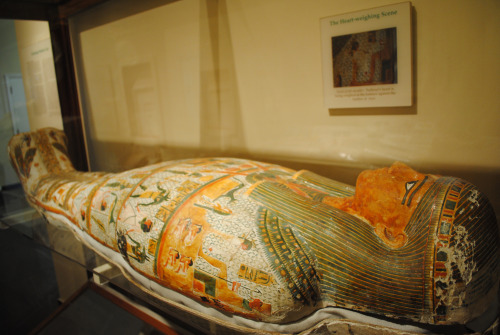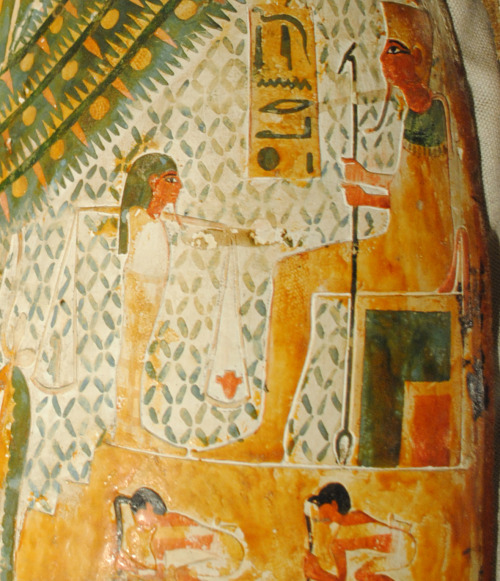Mummy case of Padimut, a wab-priest and metal engraver in the Temple of Amun-Re at Thebes during the
Mummy case of Padimut, a wab-priest and metal engraver in the Temple of Amun-Re at Thebes during the 22nd Dynasty (945-712 B.C.E). Made of cartonnage, a compound of linen, papyrus and plaster, it was formed over a mold as a single piece with an opening in the back. The mummified body of Padimut was inserted into the case through the slit in the back, which was then laced up with cords and sealed with a coating of plaster. The encased body was placed in a large wooden sarcophagus, both of which are now lost. The brightly painted scenes on the case’s surface depict important events during Padimut’s burial and successful entry into the afterlife. The central scene on the front shows Padimut’s mummy laid out on a bier in a shrine. Anudis, the jackal-headed god of mummification, is attending the mummy. Beneath the bier stand the four jars that traditionally would have contained Padimut’s liver, lungs, stomach and intestines. The jar lids represent the four sons of Horus, the protectors of the visceral organs. However, in this period the organs were in fact wrapped individually in linen packages and returned to the body cavity. Since the scenes painted on a mummy case were understood to have magical efficacy, the centuries-old traditional practice was depicted perhaps because it was believed to have more protective power. The sun-god Re appears several times on the mummy case in place of the more usual Osiris. For example, the left shoulder of the mummy case shows human-headed Re presiding over the weighing of Padimut’s head, the crucial stage in the judgement of his life (second photo). The heart has been placed in a balance to be weighed against the ostrich feather of maat (truth, justice, harmony, “what is right”). Immediately under the balance four figures pulling their hair and groveling abjectly. These represent the damned, who, have been found unworthy in the judgement, have no hope of eternity. In the register below the heart-weighing scene Padimut, dressed in the clothes of the living, is both led and followed by jackal-headed Anubis into the presence of hawk-headed Re. The mortuary goddess Hathor stands in attendance. The scroll held by the Anubis who is leading Padimut records the successful outcome of the weighing of Padimut’s heart. He has been judged worthy to receive eternal life. Offering formulas addressed to Osiris and Re-Harakhty, which run down the middle of the legs, preserve Padimut’s name and parentage. The deified king Amenhotep I (1525-1504 B.C.E) can be seen on the back of the case and again on the bottom of the feet. Amenhotep’s function was to intercede on behalf of Padimut in the final judgement. (Text: Semitic Museum). Courtesy & currently located at the Semitic Museum, Harvard University, Cambridge, MA. Photos taken by B.Kelly. -- source link
Tumblr Blog : ancientart.tumblr.com
#ancient#egyptian#history#padimut#archaeology#22nd dynasty#thebes#harvard university#semitic museum#harvardsemiticmuseum

